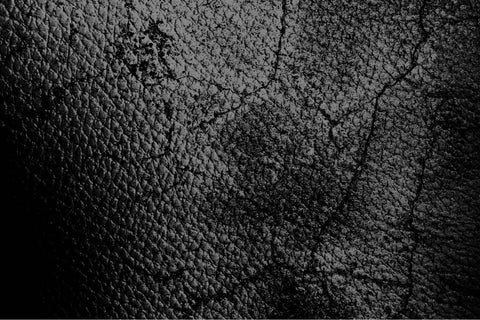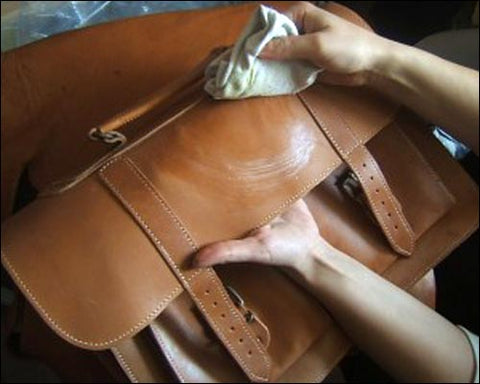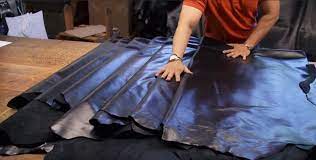
Leather is a soft, supple, and elastic material made up of many tiny fibres. As a result, leather may be made firm or soft, embossed or distorted (changing shape without causing harm), ironed, or the grain strengthened. Because of its elasticity, the leather can stretch over time and, if enough power is applied, wrinkles, creases, and pressure imprints will emerge that may be as tenacious as embossing.
Skin stretchability varies depending on the tanning method and the area of the skin. Within that hide, the stretchability of a highly polished cow skin varies.
The red portions are more than 100 percent stretchy, whereas the yellow areas may be expanded from 75 to 100 percent. There are still no values assigned to the green areas. However, there are variances within those areas as well. The leather is more stretchy in one way than the other based on the orientation of the fibre (horizontal to vertical).
Why does leather stretch?

Wrinkles, sagging and over stretching in leather!
Sounds familiar? Get to the bottom of this!
- Because of its flexibility, leather can lose its form over time. Most of the time, this results in overstretching and sagging.
- As a result of regular usage Leather furniture fabric has a tendency to become loose in specific spots.
- In the entrance side of the driver’s seat, car leather seats tend to wrinkle. In sitting places, leather begins to droop.
- If heavy or angular objects are maintained on or against incorrectly stored leather furniture, pressure marks will form.
- Leather apparel can become wrinkly if it is not properly preserved or packed in travel luggage. Bumps in the thigh or hip areas of pants are another issue.
- Bumps or wrinkles might emerge as a result of improper leather storage or bad transit circumstances. Incorrect material handling might also cause the leather to distort.
Does Leather Stretch Over Time?
Yes, this will happen as well. Because of leather’s inherent stretching capacity, simply wearing your leather apparel will make it stretch. Leather has the tendency to expand in size over time.
This is both a good and a terrible trait since you know your leather will stretch with you as you gain weight. However, if you lose weight, you may be unable to reduce it back to its previous size or even to your new slimmer size.
Wearing leather is an excellent technique to safeguard your body when participating in activities that necessitate the use of protective clothes. As an example, consider motorbike riding. It is robust and long-lasting, but if it stretches too much, you may have to pay extra to acquire clothes that fit again.
Aside from that, having a naturally expanding material next to your body allows you to perform various tasks such as reaching for products on high shelves or bending low for items on the floor or lower shelf.
How to Fix and Avoid Leather Stretching?

Heat guns are used to allow leather to change form and become wrinkle-free under stress. They are widely used in every upholstery factory where vehicle or furniture leather is prepared. In the automobile sector, short-wave infrared is employed for the same goals.
To eliminate wrinkles from leather, it is heated for 30-40 seconds. However, such procedures must be carried out with caution since leather hardens and becomes irreversibly damaged at excessively high temperatures.
Heat appears to have the ability to stretch as well as shrink leather. This is useful knowledge to have, but there are some measures to follow before administering heat. The first step is to identify the sort of leather you have.
The second step is to determine the tanning procedure used to make your outfit. The various tanning procedures are critical in determining the heat to utilise to shrink the leather. When just 131 to 140 degrees F are applied to alum tanned leather, it will shrink.
When exposed to 212 degrees Fahrenheit, chrome-tanned leather contracts, while vegetable-tanned leather shrinks when exposed to temperatures ranging from 167 to 185 degrees Fahrenheit. All of this data, including tanning and leather type, must be on the label, making it easy to discover.
Why does Leather shrink?

The most obvious explanation is that leather is created from animals, and its hide has to expand and contract in accordance with the size of the animal. It is a natural feature with no particular explanation other than the goal of hide must be able to accomplish both for the animal to live.
When the material is extracted from the animal, tanned or cured, and then converted into clothes, that quality is not lost. It is a beneficial property since humans gain and lose weight all the time but would have to spend a lot of money on new leather things if the material did not have that inherent flexibility.
Under Heat Conditions
Excessive heat can cause leather to shrink and stiffen. Damaged automobile leather around the top of the side seat, the backrests, and on displays are typical examples of this. Leather thickens as it ages because it dries out (without leather care). Leather strands harden and fragile.
This process is exacerbated by the reality that whenever the water trapped in the fibres is freed, the collagen denatures. Small local thickenings emerge in the leather fibre structure at first, then grow and consolidate. The density of the leather grows, while its dimensions shrink. This rigidity is exceptionally stable.
Leather is irrevocably damaged once shrunken, and while it may occasionally be softened slightly with suitable care chemicals, the loss of surface is irreversible and cannot be regained.
Under Wet Conditions
Even a small amount of heat is enough to shrink wet leather. Wet leather should never be dried in the sun or near a heater. Normal room temperature is ideal for drying leather.
Leather that has been properly oiled and greased will never shrink as rapidly as leather that has not been properly maintained. The tanning procedure of leather has a direct impact on its shrinkability. Vegetable-tanned leather usually begins to shrink about 70 degrees Celsius. This appears to be a high temperature, but it is easily attained when a convertible with damp, black leather seats is left out in the sun to dry. After that, the leather is “heated” and shrinks.
Modern tanning procedures, such as chrome tanning, boost the shrinkage threshold of leather so that it begins to shrink between 85 and 110 degrees Celsius.
Does Leather Shrink Over Time?
It would be good if it did because stretching is a little simpler than contracting. Usually, leather extends over time, and if the stretch becomes too great, the material must be purposely shrunk.
As you can see from recommendations and other data in this post, shrinking leather is a basic process that doesn’t require a lot of knowledge. The only issue is that you can’t completely regulate the shrink pace, so you might have to stretch the leather again to get it to fit properly.
This will be an experimentation process, so you may want to experiment on spare leather pieces first before tackling your genuine leather products.
Leather may be shrunk, which is great news for individuals who have followed a successful diet. Going down a size does not need the replacement of your clothes. It simply involves spending a significant amount of effort downsizing it to match your new frame.




 Mobile/What's App/Wechat
Mobile/What's App/Wechat E-Mail
E-Mail ADD
ADD




